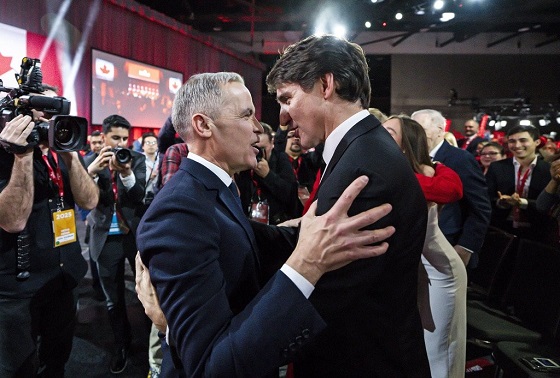Business
Ontario leaders back East–West corridor linking Alberta energy across the country

Matthew Slotwinski, CEO of the Sarnia-Lambton Economic Partnership. Photo courtesy SLEP
From the Canadian Energy Centre
‘The sooner this gets done, the better’
From his desk in Marathon, Ont., a small community on the north shore of Lake Superior, Mayor Rick Dumas sees the concept of an energy corridor to Western Canada’s oil and gas as a chance to reshape his region’s future.
The Ontario government issued a request for proposals on August 7 for a feasibility study into the idea, which would move energy products from across the Prairies and Northern Ontario to consumers and exporters in the East.
“Projects like the East-West Energy Corridor are exactly what Northwestern Ontario has been calling for — an opportunity to be at the forefront of a nation-building initiative,” said Dumas, who is also president of the Northwestern Ontario Municipal Association, representing the districts of Kenora, Rainy River and Thunder Bay.
“It means new jobs, greater economic opportunity, and a real commitment to building a cleaner, stronger, and more resilient country together.”
The feasibility study will map potential pipeline routes linking Alberta to Southern Ontario’s refining sector and new tidewater ports, including on James Bay, Hudson Bay and the Great Lakes.
It will also assess the construction or expansion of a refinery, examine Indigenous equity opportunities, and even explore the creation of a Canadian strategic petroleum reserve.
Support for the corridor also comes from Southern Ontario, where the region’s petrochemical and energy industries depend on oil and gas supplies delivered by a pipeline that crosses Michigan.
“We believe this represents an opportunity to achieve both energy security for Ontario and Canada, and economic growth and diversification potential,” said Matthew Slotwinski, CEO of the Sarnia-Lambton Economic Partnership.
“Long-term, reliable and secure feedstock supply is necessary for the sustained success and potential growth of our current operations.”
The Sarnia-Lambton region is home to Ontario’s largest concentration of energy infrastructure, including refineries, chemical plants, power generators, and Enbridge Gas’s Dawn Hub, where much of the province’s natural gas supply is gathered for commercial distribution.
The region is also exploring new opportunities in liquefied natural gas (LNG), hydrogen, and alternative fuels.
“Very few of Ontario’s cars would drive, flights would fly, or homes would be heated without the products that originate from the Sarnia-Lambton energy and chemistry complex,” Slotwinski said.
“Our industry leaders need to be front and centre in identifying how they can be harnessed as part of any nation-building exercise.”
Labour groups are also throwing their weight behind the energy corridor initiative, pointing out that Michigan’s governor wants to shut down the pipeline that carries Canadian oil and gas through its borders.
Mike Gallagher, business manager of the International Union of Operating Engineers (IUOE) Local 793, told CBC that he supports the corridor as a source of jobs and independence.
“As far as I’m concerned, the sooner this gets done, the better,” he said.
“A new pipeline would not only create jobs, it would strengthen our country’s independence and is exactly the kind of nation-building project that Prime Minister Carney promised to deliver.”
Automotive
Canadians rejecting Liberal’s EV mandates because consumers are rational

From Resource Works
Bad policy, not misinformation, is to blame for the decline in EV sales
It was a clever move for federal minister Gregor Robertson to stand in Victoria and blame the oil and auto industries for spreading “misinformation” about electric vehicles.
If people don’t follow a government order, then someone else must have lied to them.
But the truth is simpler, and more uncomfortable for Ottawa and Victoria: Canadians are against aggressive EV mandates because the policies behind them are not based on reality.
Politicians have been pushing electric vehicles (EVs) as a cornerstone of the fight against climate change for years, promising a cleaner future through ambitious mandates and generous rebates.
All of this effort looked good on paper: passing laws, handing out thousands (millions, billions) in subsidies, paving the way for Canada’s transition to an electric future.
But, in real life, it’s just not working out this way.
Why? Because instead of crafting long-term rules based on the realities of infrastructure, cost, and consumer choice, Ottawa rushed ahead with policies that ignored market signals.
They assumed subsidies would keep EV sales flowing indefinitely, only to be shocked when sales plummeted once the rebates dried up.
Canadians are responding rationally to high prices, unreliable charging networks, and impractical mandates.
Not long ago, Ottawa set ambitious, unattainable targets: 20 percent zero-emission vehicle sales by 2026, 60 percent by 2030, and 100 percent by 2035.
British Columbia went further, aiming for 26 percent by 2026, 90 percent by 2030, and 100 percent by 2035.
In theory, it looked achievable. In practice, it’s been a wake-up call.
The numbers tell the story. Statistics Canada reported that EVs accounted for 18.29 percent of new vehicle sales in December 2024. Just four months later, when Ottawa’s iZEV program ran out of funds and provincial rebates ended, that figure crashed to 7.53 percent.
In British Columbia, once a leader in EV adoption, the market share dropped from nearly 25 percent in mid-2024 to 15 percent a year later.
Quebec, long the most EV-friendly province, saw a similar decline when its $7,000 subsidy was slashed nearly in half.
Why? Canadians have been very clear.
Cost is the biggest barrier, according to polls like this one from Ipsos in 2025. But this isn’t the only issue.
Ipsos found 56 percent of British Columbians oppose EV mandates, with even higher resistance among older households and those outside Metro Vancouver. People resent being told they must buy expensive cars they can’t easily charge or fully trust in harsh winters.
Subsidies made high sticker prices tolerable for middle-class families, but when the rebates vanished while mandates and fines remained, buyers walked away.
Barry Penner of the Energy Futures Institute put it bluntly: governments “put the cart before the horse,” demanding widespread adoption before ensuring affordability or infrastructure.
The financial penalties for automakers are steep. Missing federal targets by 10 percent could mean hundreds of millions in fines.
In British Columbia, dealers face $20,000 penalties for every gas-powered car sold over the mandated ratio. Those who can’t comply often buy credits—frequently from Tesla, a California-based company that benefits while Canadian businesses foot the bill. These rules aren’t just hitting “Big Oil”; they’re straining local dealers and sending money abroad.
Infrastructure is another glaring issue. Ottawa estimates Canada has 33,700 chargers today but needs 679,000 by 2040—an average of 40,000 new chargers annually for 15 years, a pace experts call unrealistic.
In British Columbia, Penner notes the province has just 5,000 chargers now and needs 40,000 more by 2030. Meeting the 2035 mandate would also require electricity equivalent to two additional Site C dams, even as B.C. relies on 20 to 25 percent of its power from external sources, often fossil fuels.
Canadians aren’t against cleaner technology—they’re against being forced into choices that don’t fit their lives. The frustration stems from policies that feel disconnected from the realities of cost, convenience, and infrastructure. More blame or moralizing won’t fix this.
Penner has urged governments to “take our foot off the gas and realign our policies with reality.”
That could mean reinstating rebates if mandates persist, investing heavily in charging networks, or setting broader emissions targets that give consumers real choices instead of rigid quotas.
The EV dream will keep stalling unless that happens. It’s not because Canadians don’t know what’s going on; it’s because governments made decisions based on wishful thinking.
Business
Canada Is Sleepwalking Into A Cartel-Driven Security Crisis

From the Frontier Centre for Public Policy
The U.S. is escalating its fight against drug cartels by treating them like terrorist organizations, while Canada risks becoming a safe haven if it fails to act. Cartels already exploit Canadian banks, real estate, and trade, posing national security threats beyond drugs. In this commentary, Frontier Centre senior fellow Scott McGregor urges Canada to tighten ownership laws, strengthen enforcement, and apply terrorism financing tools—otherwise, it will become the weak link vulnerable to cartel infiltration and corruption.
The U.S. is getting serious about drug cartels. If Canada doesn’t step up, we risk becoming their next base of operations
According to a recent New York Times report, U.S. President Donald Trump has given the Pentagon the green light to target Latin American drug cartels. Not “target” in the metaphorical sense—this is the real thing. Drones. Intelligence ops. Boots, if not yet on the ground, then certainly in the briefing rooms.
This isn’t just another law-and-order flex. It’s a clear signal that cartels are no longer being treated like street thugs with fast cars and gold-plated pistols. The U.S. is starting to treat them as what they’ve become: strategic actors capable of hollowing out nations through violence, economic sabotage and political manipulation.
Canada, take note. These cartels aren’t lurking just south of the Rio Grande. They’re here—moving narcotics through our ports, washing dirty money through casinos and real estate, and slipping illicit profits into the bloodstream of our legitimate businesses. The same loopholes that let hostile states meddle in our economy—opaque ownership laws, sluggish enforcement, paper-thin oversight—are a buffet for criminal networks.
The U.S. move to label cartels as foreign terrorist organizations isn’t just semantics. It unlocks serious tools: sanctions, asset freezes, intelligence collection, and expanded interagency coordination. And yes, it will inevitably reshape how American agencies engage with Canadian police, prosecutors and financial watchdogs. Whether we’re ready or not.
Our private sector, already lumbering under the alphabet soup of the Proceeds of Crime (Money Laundering) and Terrorist Financing Act, if you’re into that sort of thing, will now face higher expectations. The law technically requires banks, real estate firms, casinos and others to flag dodgy transactions. But reality hasn’t lived up to regulation. Just ask TD Bank, which somehow let billions in suspected drug money pass through its accounts like it was business as usual.
Now, with U.S. regulators treating some cartels like terror networks, those Canadian reporting obligations take on a whole new urgency. Vague links to shady partners won’t be brushed aside—they’ll be flagged, frozen and maybe prosecuted. Transactions won’t just be scrutinized for origin—they’ll be examined for intent, connection and risk exposure.
And if you think this only applies to bags of cash under the table, think again. Trade-based laundering—fudged invoices, over- or underpriced exports, corporate shell games—is very much in the crosshairs. So is service-based laundering: professional firms, logistics handlers, consultants. If it moves, it can be used. And if it moves dirty money, it’s fair game.
For businesses with Latin American partners or operations in high-risk sectors—agriculture, commodities, shipping, construction—the rules have changed. Every client, every partner, every middleman becomes a compliance risk. Insurers and investors are already sharpening their pencils. If you thought due diligence was annoying before, just wait.
But the private sector won’t be the only one feeling the heat. Canadian law enforcement can’t afford to lag behind. If the U.S. is reaching for terrorism laws to take down cartel operations, Canada can’t keep leaning on an outdated “organized crime” framework better suited to The Sopranos reruns than transnational hybrid conflict.
Integrated enforcement units will need more than pep talks—they’ll need authority, funding and legal backing to go after not just cartel foot soldiers, but the enablers hiding in plain sight: financial fixers, trade brokers and regulatory sleepers.
It’s time to revisit whether our terrorism financing laws can apply to cartels that, let’s face it, look and act an awful lot like geopolitical insurgents. If they meet the Criminal Code’s thresholds, why aren’t they being treated accordingly?
Because this isn’t just about drugs. It’s about hybrid warfare.
Cartels are no longer just violent criminal enterprises. They’ve become destabilizing forces—sometimes aligned with hostile regimes, always exploiting weak institutions. Take Venezuela’s Cartel de los Soles. It’s allegedly run by senior government officials. That’s not just a crime ring. That’s a criminal state actor.
When such networks pass through Canada, they don’t just bring drugs. They bring the risk of corruption, economic distortion and political interference. In short: they’re a national security threat.
And here’s the kicker: if Canada doesn’t match the U.S. posture, we become the soft underbelly. Cartels will exploit every gap between Washington’s crackdown and Ottawa’s inertia. Even if Canada doesn’t change a thing, the private sector won’t get a pass. U.S. regulators don’t particularly care what Parliament does—they care about risk exposure. And they will act accordingly.
The U.S. designation confirms what many in intelligence and enforcement have long known: the cartels use the same toolkit as hostile states: illicit finance, economic disruption and market infiltration. That makes them more than a policing challenge. They are a test of national resilience.
Canada’s response needs to be sharp, strategic and immediate. That means tightening ownership laws, expanding the operational muscle of FINTRAC—the federal agency that tracks suspicious financial transactions and combats money laundering—and properly resourcing joint enforcement teams. Above all, we must stop treating compliance as a box-checking exercise and start treating it as the security tool it was meant to be.
Washington’s message couldn’t be clearer. If Canada stays on cruise control, the cartels will set up shop here—and we’ll be the ones footing the bill in corrupted institutions, compromised markets and communities left to deal with the fallout.
Hybrid threats don’t wait for committee reports. They move fast, adapt quickly and embed deeply. So should we.
Scott McGregor is an intelligence consultant and co-author of The Mosaic Effect. He is a senior fellow at the Council on Countering Hybrid Warfare and writes here for the Frontier Centre for Public Policy.
-

 Automotive1 day ago
Automotive1 day agoCanadians rejecting Liberal’s EV mandates because consumers are rational
-

 Business2 days ago
Business2 days agoCanada Is Suffocating Its Future One Policy At A Time
-

 Bruce Dowbiggin19 hours ago
Bruce Dowbiggin19 hours agoMic Drop: The Thought Police Are Coming To Take You Away
-

 Business2 days ago
Business2 days agoCanada Is Sleepwalking Into A Cartel-Driven Security Crisis
-

 C2C Journal18 hours ago
C2C Journal18 hours agoCanada’s Health-Care Monopoly is Killing Us
-

 Censorship Industrial Complex1 day ago
Censorship Industrial Complex1 day agoCanadian gov’t claims privacy provision in online censorship bill was “accidentally” removed
-

 Crime24 hours ago
Crime24 hours agoU.S. Missile Strike on Alleged Narco-Boat Tied to Maduro and Ohio Indictment of Chinese Firms Signal Dramatic Escalation in War on Fentanyl
-

 Business2 days ago
Business2 days agoPoilievre calls on Carney to immediately scrap the Temporary Foreign Worker Program







